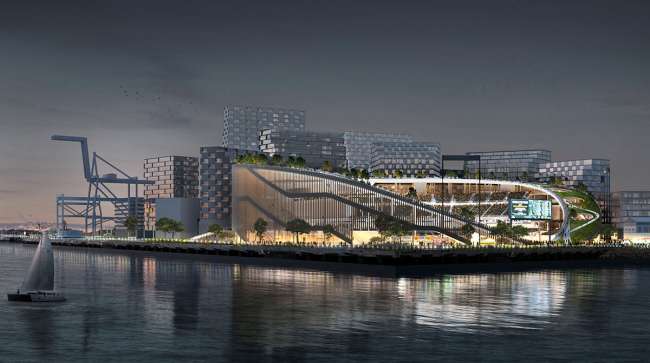Senior Reporter
Ballpark at Port of Oakland Takes Step Forward

[Stay on top of transportation news: Get TTNews in your inbox.]
Major League Baseball’s Oakland Athletics are one important step closer toward winning approval to build a ballpark as part of a $12 billion commercial development project at an abandoned terminal at the Port of Oakland.
But while the team nears a potential victory, trucking industry officials remain opposed to the plan because they say it will disrupt port operations, and they intend to keep fighting the proposal.
Three legal challenges to the project’s Environmental Impact Report tentatively were rejected by Alameda County Superior Court Judge Brad Seligman on Aug. 30.

Seligman
Seligman ruled that the city’s environmental analysis for development at the Howard Terminal was largely correct, with one minor exception. If the court sided with opponents of the city’s plan and the team’s, it could delay and possibly scuttle the project.
In April, the East Oakland Stadium Alliance, Union Pacific Railroad, Capital Corridor Joint Powers Authority and a coalition of port workers, trucking industry groups and cargo-terminal operators filed the lawsuit.
In his 70-plus-page ruling, Seligman sided with the development’s supporters and team with one exception, questioning how the project would disperse and mitigate wind at the port. The judge said the EIR cannot determine what the wind currents would be like because they do not have a final design for the development. And, there is no performance standard for “what is too windy” for this type of a project.

Schrap
Harbor Trucking Association CEO Matt Schrap said in baseball parlance the contest now is in the late innings and the A’s and stadium’s supporters are ahead by several runs.
“There are still some more steps that are involved here; it’s getting closer, but they, the city cleared some hurdles,” Schrap said. “They have all the political support, but the game is not over quite yet. We’re probably in the eighth inning, but whether or not we go into extra innings or see a walk-off in the ninth inning, we’ll find out.”
Schrap said Oakland Mayor Libby Schaaf, who is term-limited and must leave office in 2023, does not want to lose another professional sports team. In 2019, the NBA’s Golden State Warriors left Oakland Arena, adjacent to the baseball stadium, for Chase Center on the waterfront in San Francisco.
Our City will continue to work closely with the @Athletics on a shared vision + timeline to bring a responsible deal for a new, iconic ballpark district to the City Council for a vote this year. #DrumTogether — Libby Schaaf (@LibbySchaaf) July 19, 2022
A year later, the NFL’s Raiders moved from Ring Central Coliseum, which it shared with the A’s, to Las Vegas and Allegiant Stadium, which specifically was built for the Raiders and the University of Nevada-Las Vegas football team.
“She doesn’t want her legacy to be the Raiders, Warriors and the A’s all leaving Oakland. No one wants to see the A’s leaving Oakland,” Schrap said. “It’s been this war of attrition. They’re fighting and spending millions and millions on lawyers and consultants. The A’s have said they won’t build at the Coliseum site, and they say they can’t make money there.”
Trucking leaders say Oakland should follow the model that has been used in Philadelphia and other cities — demolish the old basketball and hockey venue, that now is rarely used, and build a baseball-only stadium on the site. Over the past 80 years, Philadelphia has done this several times. Numerous facilities have been constructed at the same location because it is accessible to mass transit and Interstate 95 is nearby, along with several other highways.
The #HowardTerminal saga trudges on… https://t.co/Mdr9iJNSG0 — Matt Schrap (@mattschrap) August 2, 2022
At the same time that Oakland city officials are pursuing this development, Las Vegas continues to aggressively court the A’s. MLB officials and the team have held numerous meetings with private sector and government leaders, discussing a possible domed stadium along the Strip. Commissioner Rob Manfred has warned the stadium situations in Oakland and Tampa-St. Petersburg must be resolved soon because officials consider both facilities outdated and no longer viable from a competitive and revenue standpoint.
The move to build a stadium and commercial development comes as Port of Oakland is struggling to find business. The port is critical, especially for exports from the central California agricultural basin, frozen protein from the Midwest and grain products.
Want more news? Listen to today's daily briefing above or go here for more info
As shipping rates have skyrocketed, hundreds of vessels have bypassed the port and instead unload at the ports of Los Angeles and Long Beach. Those ships then return to Asia empty to be reloaded for another trip to the U.S.
The products destined for Oakland instead have been transported north by truck. In July, container volume fell by 28% year-over-year compared with 2021.
Schrap said building a ballpark will further damage the port.
“The team wants that waterfront property. They don’t care what the impact it has on the Port of Oakland and agriculture exports,” Schrap said. “Shippers will vote with their feet. What will stop them from leaving?”
Up next, the California Department of Toxic Substances Control and Alameda County must give their approval before the project moves forward.




